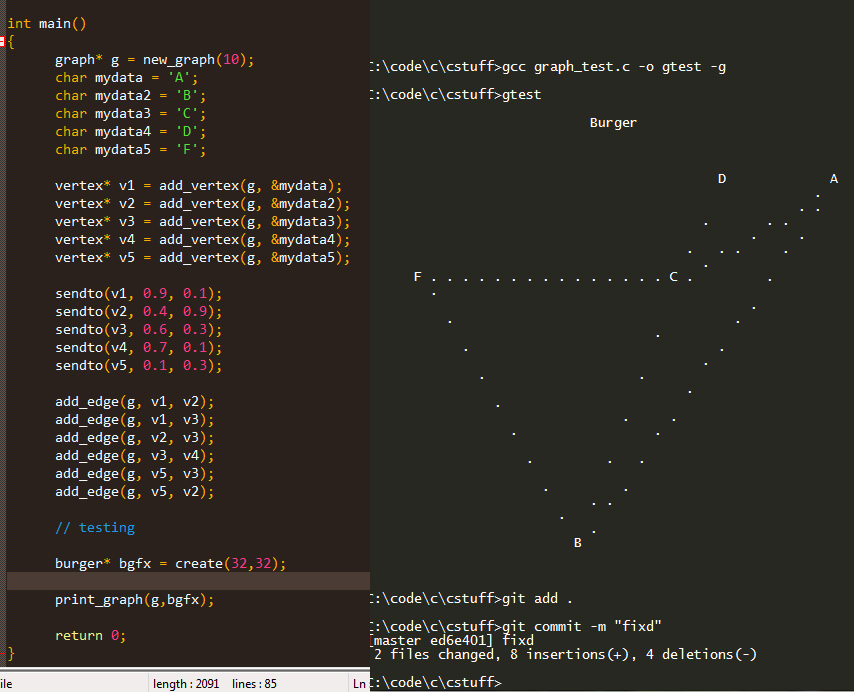Several times I find myself wanting to visualize something in 2D, but can’t bother to fire up OpenGL or other cumbersome API.
So I wrote a simple program which I called BurgerGFX, with 2 core functionalities: draw point and draw line. I find this to be quite enough for simple applications such as viewing a graph.
Setting up the drawing canvas, which I call burger, is simple: call create(width, height), which returns a pointer to the burger. Then simply call the draws, prints and cleans as needed.
Here’s the code for your enjoyment.
/*
File: burgergfx.c
Copyright (c) 2014 Leonardo Brito <lbrito@gmail.com>
This software is free software; you can redistribute it and/or modify
it under the terms of the GNU General Public License as published by
the Free Software Foundation; either version 2 of the License, or
(at your option) any later version.
This program is distributed in the hope that it will be useful,
but WITHOUT ANY WARRANTY; without even the implied warranty of
MERCHANTABILITY or FITNESS FOR A PARTICULAR PURPOSE. See the
GNU General Public License for more details.
You should have received a copy of the GNU General Public License along
with this program; if not, write the Free Software Foundation, Inc., 51
Franklin Street, Fifth Floor, Boston, MA 02110-1301 USA.
*/
#include
#include
#include
typedef struct
{
int w,h;
char* burger_matrix;
} burger;
/**
* @brief Create a new w x h burger
*
* @param [in] w width
* @param [in] h height
* @return pointer to burger
*/
burger* create(int w, int h)
{
burger* bgfx = malloc(sizeof(burger));
bgfx->w = w;
bgfx->h = h;
bgfx->burger_matrix = malloc(sizeof(char)*w*h);
int i=0;
for (;i<w*h;i++) bgfx->burger_matrix[i] = '.';
return bgfx;
}
/**
* @brief Get the appropriate cell from a normalized x coordinate
*
* @param [in] b burger
* @param [in] x normalized coordinate
* @return cell index
*/
int get_norm_x(burger* b, double x)
{
return (int) round(b->w*x);
}
/**
* @brief Get the appropriate cell from a normalized y coordinate
*
* @param [in] b burger
* @param [in] y normalized coordinate
* @return cell index
*/
int get_norm_y(burger* b, double y)
{
return (int) round(b->h*y);
}
/**
* @brief Fill the burger with whitespace
*
* @param [in] b
*/
void clean_burger(burger* b)
{
int i=0;
for (;iw*b->h;i++) b->burger_matrix[i] = ' ';
}
/**
* @brief Put char in cell
*
* @param [in] b burger
* @param [in] dx normalized x position
* @param [in] dy normalized y position
* @param [in] c char to be put
*/
void put_burger(burger* b, double dx, double dy, char c)
{
int x = get_norm_x(b, dx);
int y = get_norm_y(b, dy);
b->burger_matrix[y+(x*b->w)] = c;
}
/**
* @brief Put char in cell
*
* @param [in] b burger
* @param [in] x cell index
* @param [in] y cell index
* @param [in] c char to be put
*/
void put_burger_int(burger* b, int x, int y, char c)
{
b->burger_matrix[y+(x*b->w)] = c;
}
/**
* @brief Print the current burger
*
* @param [in] bgfx
*/
void print_burger(burger* bgfx)
{
int i = 0, j = 0;
printf("\n");
for (;i<(bgfx->w/2)-2;i++) printf(" ");
printf("Burger\n");
for (i=0;ih;i++)
{
for (j=0;jw;j++)
{
printf("%c ",bgfx->burger_matrix[i+(j*bgfx->w)]);
}
printf("\n");
}
}
/**
* @brief Draw line from point 1 to point 2 on burger
*
* @param [in] bgfx
* @param [in] dx1 point 1 normalized x coord
* @param [in] dy1 point 1 normalized y coord
* @param [in] dx2 point 2 normalized x coord
* @param [in] dy2 point 2 normalized y coord
*/
void put_line(burger* bgfx, double dx1, double dy1, double dx2, double dy2)
{
int x1 = get_norm_x(bgfx, dx1);
int y1 = get_norm_y(bgfx, dy1);
int x2 = get_norm_x(bgfx, dx2);
int y2 = get_norm_y(bgfx, dy2);
int i = 0;
float a = (float)(y2-y1)/(float)(x2-x1);
if (x1<x2)
{
for (i=x1; i {
int x = i - x1;
int y = (int) (a*x) + y1;
put_burger_int(bgfx, i, y, '.');
}
}
else
{
for (i=x2; i<x1; i++)
{
int x = i - x2;
int y = (int) (a*x) + (y1 put_burger_int(bgfx, i, y, '.');
}
}
}